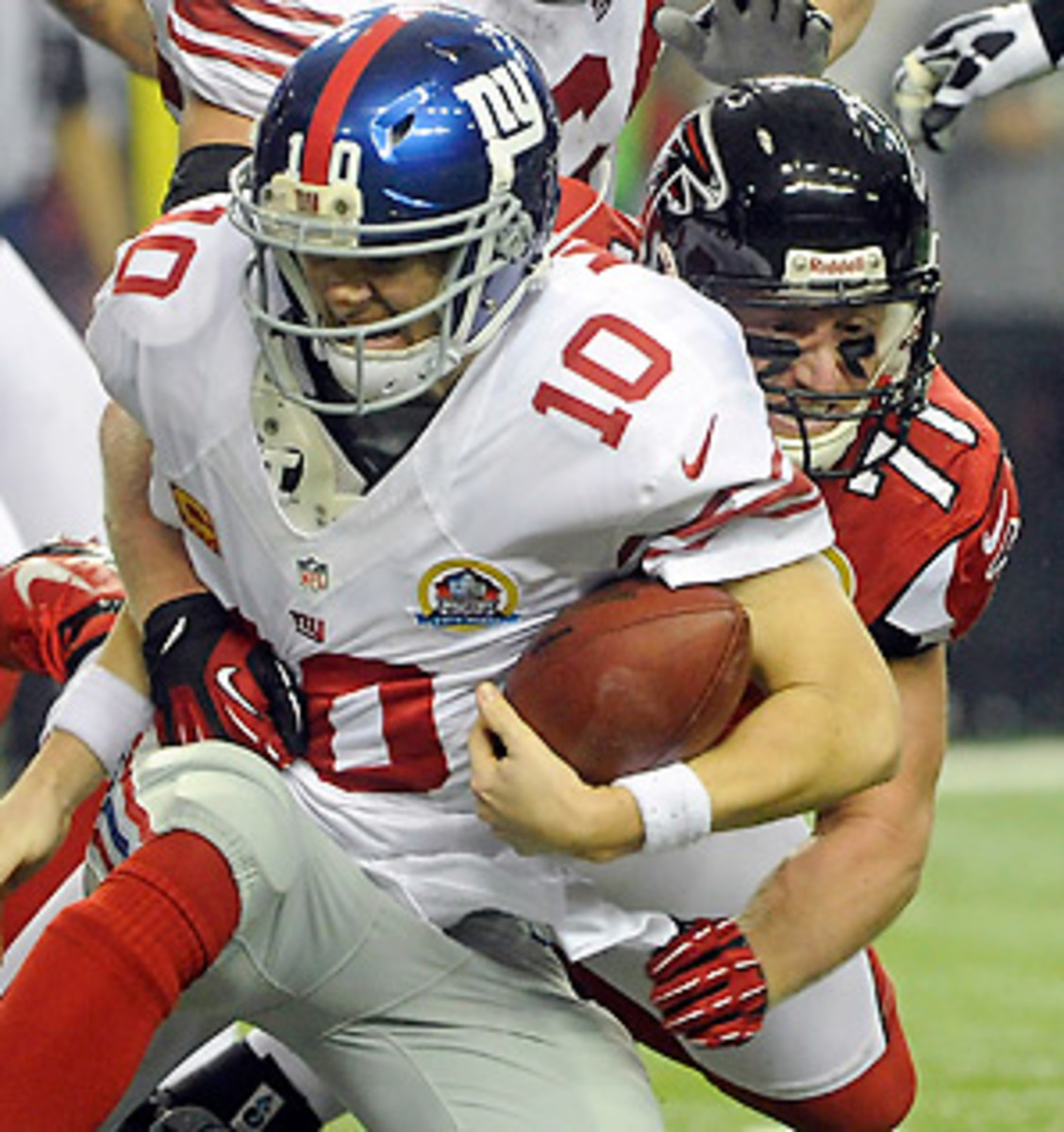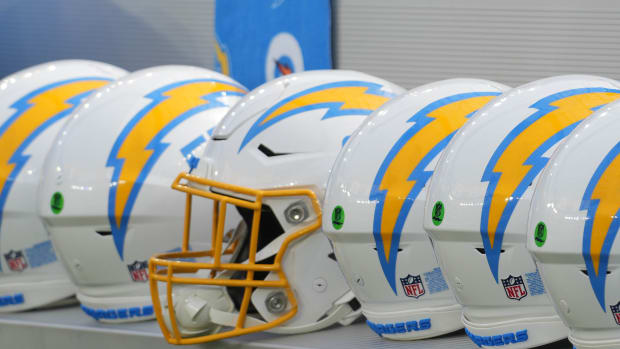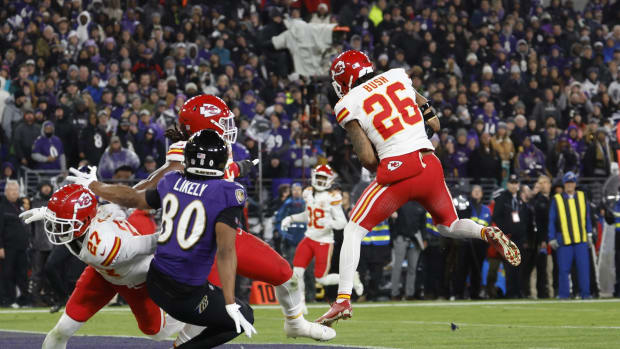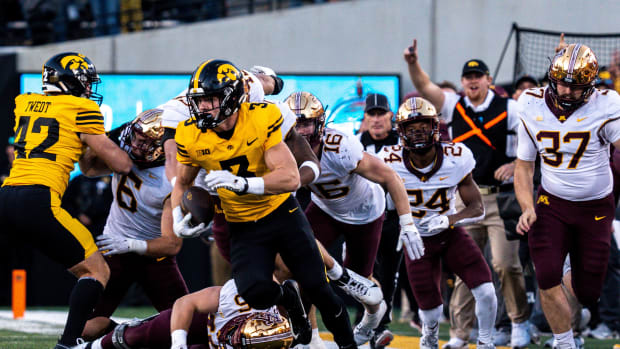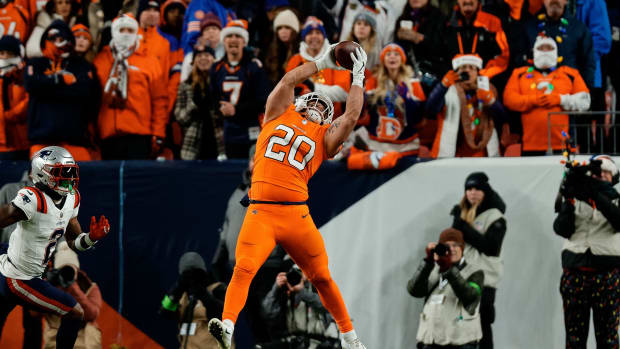Break It Down: Falcons' D does it again
The Falcons kept the Giants scoreless for the first time in a regular season game since 1996. (John Amis/AP)
The zone-read, triple-option has blasted its way onto the NFL scene, thanks to athletic quarterbacks like Robert Griffin III, Cam Newton, Colin Kaepernick and, yes, even Tim Tebow. One of the major reasons that offensive tactic is successful is that it relies on deception -- making the defense chase a decoy ball carrier while the actual runner heads another way.
In a lot of ways, Mike Nolan employs the defensive version of that strategy.
Nolan, in his first year as the Falcons' defensive coordinator, has given opposing quarterbacks headaches this season with his play calling. What you see is very rarely what you get with Nolan, who utilizes disguised looks all over the field -- showing blitz from one side, then bringing heat from another; morphing a man-to-man into a zone; even using personnel in unusual ways.
A team with a mobile quarterback can beat Nolan's attack (see: Newton, Cam, who finished 1-1 vs. Atlanta this season), but the Falcons' defense has found great success against pocket passers like Peyton Manning, Drew Brees and Eli Manning, especially in the Georgia Dome.
Sunday, it was Eli's turn to go through the ringer against the Falcons. He failed miserably in a 34-0 loss.
What did Atlanta do to throw the Giants' signal-caller so far out of whack? Time to Break It Down ...
Figuring out what happened Sunday starts with two obvious points: 1. Eli Manning played poorly, plain and simple; 2. Atlanta enjoyed enormous success when it was able to generate pressure.
The second is a pretty general rule of thumb across the board -- get some heat on the quarterback and you'll have an easier time defending him. But Manning was particularly rattled Sunday. According to Pro Football Focus, he was under pressure on 10 of 26 drop-backs ... and recorded a 6.9 QB rating on those plays.
Both of his interceptions occurred with pressure in his face, and it took Atlanta just two snaps to force the first. The Giants lined up on that play with two wide receivers, two tight ends and RB David Wilson behind Manning. The Falcons countered with a stretched 4-3, with Akeem Dent manning the middle, Stephen Nicholas lined up over Martellus Bennett wide right and Sean Weatherspoon left.
The Falcons' D-line crashed to the right, while Weatherspoon came off the left edge, blew through Wilson's block attempt and put Manning under duress. Manning tried to hurry the ball out to Hakeem Nicks, but Asante Samuel jumped the route.
The Falcons managed to create pressure with just a four-man rush on Manning's second pick. Just as on the first INT, Manning was hit as he targeted Nicks. This time, Thomas DeCoud stepped in front of the pass (as an open Victor Cruz drifted across the middle, unseen by the rushed QB):
Here, we get a solid glimpse at some of the post-snap shifting that Nolan has used so masterfully at times this season. Asante Samuel actually matched up with Nicks in the pre-snap alignment, with about a nine-yard cushion between them. DeCoud (red X), meanwhile, sat in the middle of the field, showing a possible zone look.
Instead, at the snap, Samuel dropped quickly while DeCoud picked up Nicks one-on-one. Manning threw the pass as if the initial look held -- had Nicks been up against Samuel, he no doubt would have had inside position on the slant.
The whole idea is to create confusion. And what makes things even more difficult for offenses facing Nolan is that the tape a team reviews often does not match up with what it sees come game time.
Case in point: Against Denver back in Week 2, the Falcons played almost the entire game in a nickel (five DB) set. Sunday, they applied a heavy dose of dime (six DB) sets -- even as they flashed traditional 4-3 looks.
Here's one example, on a play that resulted in a sack of Manning. Pre-snap, the Falcons appeared to be in a Cover-1 and that red X closest to the line is DeCoud, a safety, showing blitz.
Instead, however, DeCoud flared out on Bennett and the Falcons rushed four, meaning that they would up with six defensive backs plus a linebacker in coverage. That approach allowed them to match up one-on-one with three Giants targets, double-team Victor Cruz (circled) over the middle, maintain a deep safety (Chris Hope is camouflaged by the Falcons' logo at about the 46) and keep Weatherspoon underneath to watch for any late-releasing safety valves.
Weatherspoon was one of the keys to Atlanta's success Sunday, as he often was the lone linebacker on the field in those dime looks.
Nolan asked him to pressure the quarterback plenty, too, as we saw on Manning's first pick. Later, he forced an incompletion by putting the heat on Manning again, thanks to a stunt from the Falcons' defensive tackles that left New York's offensive line confused:
With his back releasing in a route, Manning had no one left to pick up Weatherspoon:
But the Falcons' blitzes also work plenty, regardless of blocking scheme, because of the smoke-and-mirrors approach by Nolan. Back in Week 13, a Weatherspoon rush helped contribute to one of Brees' five interceptions.
That play started with Nicholas showing blitz in between the DT and DE to Brees' left, with the Falcons in a nickel set. Nichols and John Abraham dropped in coverage, with Weatherspoon coming shooting up a middle gap.
Darren Sproles managed to slow Weatherspoon some, but by needing to stay in and block, Sproles could not dive out as a safety valve and also could not help chip Kroy Biermann.
Biermann came off the right edge of New Orleans' line to hit Brees and force a pick.
Like the triple-option, this is all about forcing quarterbacks to see things that are not there. The Falcons do this by changing their defensive looks two or three times, even within the same play.
The photo below appears to be a two-deep, man-to-man defense. It winds up being a three-deep zone. Weatherspoon (red X) is the lone linebacker on the field; DeCoud, next to him in what would traditionally be a linebacker's spot, sprints deep at the snap, giving the Falcons three deep safeties.
The defensive movement results in this:
The Falcons essentially give up the underneath routes on 1st-and-10. Manning still tries to fit a pass in to Jerrel Jernigan (yellow circle), who has a line of defenders in front of him and corner Dominique Franks deep along the sideline. Circled in red is DeCoud, who has the deep middle secured.
Peyton Manning saw a similar setup way back in Week 2 -- the Falcons dropping to basically have a 4-3 in the back seven. But the play on which one of Peyton's three picks resulted again emphasizes Nolan's trickery.
While the Falcons wound up in essentially the same spots as they did on that Eli Manning incompletion, they started in a Cover-1 against the Broncos, with two linebackers on the field -- and one showing blitz.
But the shifting post-snap placed three Falcons deeper than 10 yards and four right about at the first-down marker. Peyton Manning tried to squeeze a pass in deep to Brandon Stokely but a waiting defender jumped in front.
The lesson learned from watching Atlanta's defense is that each play is its own unique entity -- trying to pick out tendencies from Nolan's fronts and personnel groupings is borderline fruitless.
Beating the Atlanta defense, especially for a team with what would be considered a non-mobile quarterback, requires that QB to be on his game. Peyton Manning eventually found a groove, attacking the holes Atlanta was unable to cover as it adjusted its looks post-snap. Peyton's brother, Eli, never found that comfort zone.
Offenses have to approach every play against Nolan's defense the way it would approach a blitz. But as opposed to attacking where a blitz comes from, the goal should be to find the one or two defenders who are responsible for huge windows -- a safety dropping into that robber spot down the middle of a Cover-3, a linebacker showing blitz at the line and trying to get out to cover the flat. Those are the weak points in Nolan's attack.
































